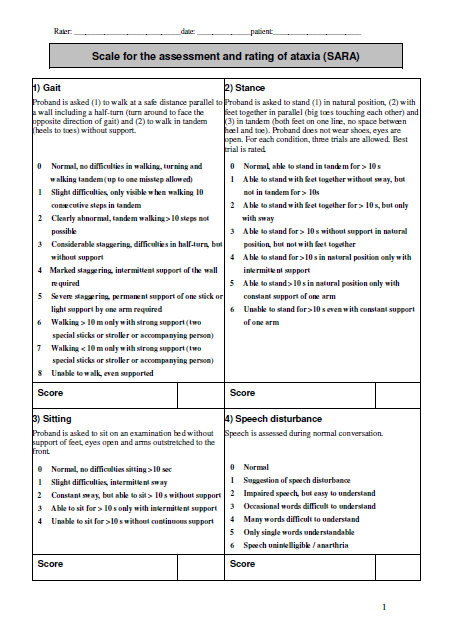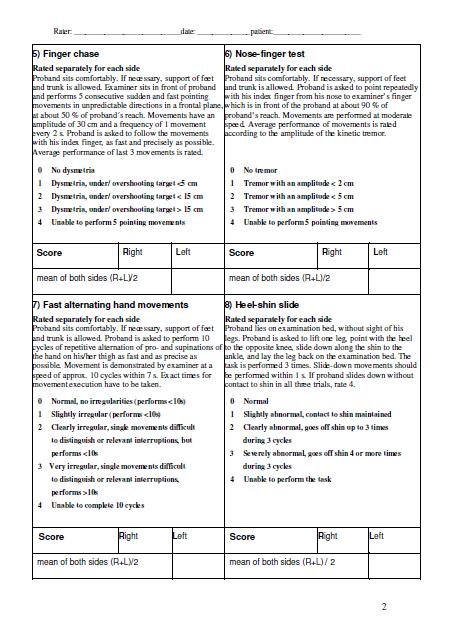Ataxia Is Assessed Using Which of the Following Methods
DIAGNOSTIC INVESTIGATIONS Haematology. Ataxia diagnosis and assessment 1.
Ataxia might be observed which relates to.

. Over the course of the intervention 3 months subjects will be assessed using the following rating scale and definitions of ataxia and nystagmus prior to the first and second intravenous drug administrations then every 30 minutes for four hours after drug administration. PC1 PC2 Gender binary AAO and the length in normal and expanded CAG repeats. The following disease groups are covered by ERN-RND.
Recommends the use of the Scale for the Assessment and Rating of Ataxia SARA as best clinical practice for the assessment and rating of Ataxia patients. Quantitative assessment of severity of ataxia-specific gait impairments from wearable technology could provide sensitive performance outcome measures with high face validity to power clinical trials. The SARA and the BARS are reliable and valid measures of ataxia for children with PFT.
Methods 20 children mean age 99 years range 5-15 years who had undergone resection of a posterior fossa tumour were assessed using the Scale for the Assessment and Rating of Ataxia SARA Brief Ataxia Rating Scale BARS and the Pediatric Evaluation of Disability Index PEDI at the following time points. Stance 0-6 points 3. Children were assessed using the Scale for the Assessment and Rating of Ataxia SARA scale and the Brief Ataxia Rating Scale BARS scale.
9 Semiquantitative scales including the International Cooperative Ataxia Rating Scale ICARS and the Scale for the Assessment and. This new assessment tool has fewer assessment items. When completing the outcome measure each category is assessed and scored accordingly.
Methods Thirty-five children median age 9 years range 415 having resection of PFT were assessed using the Scale for the Assessment and Rating of Ataxia SARA Brief Ataxia Rating Scale. Recently proposed the Scale for the Assessment and Rating of Ataxia SARA as an alternative. The severity of ataxia is typically assessed using motor function tests such as the finger-to-nose maneuver in which a patient alternates between touching hisher nose and the clinicians outstretched finger.
While assessment of tandem repeat expansions requires specialized PCR andor Southern blot gene-by-gene analysis. Is which of the following. All statistical analyses were performed using SPSS version 200 SPSS Inc Chicago IL.
Ataxia outcome measures Children were assessed using the Scale for the Assessment and Rating of Ataxia SARA scale 11 and the Brief Ataxia Rating Scale BARS scale 12. This document was supported by and done in the framework of the European Reference Network for Rare Neurological. It has eight categories with accumulative score ranging from 0 no ataxia to 40 most severe ataxia.
An important method of assessment in which the practitioner observes the patients appearance gate behavior etc. Postural instability and gait ataxia are the most frequent initial clinical symptoms in SCA3 patients. The SARA is used in clinical paediatrics and has.
The SARA and the BARS are reliable and valid measures of ataxia for children with PFT 13. However the daily use of this scale in ataxic patients is diffi cult due to its many assessment items3 Accordingly Schmitz-Hübsch et al. The SARA is a clinical scale based on a semiquantitative assessment of cerebellar ataxia.
CEREBELLAR ATAXIA NITHIN NAIR 2. These included detailed limb coordination DLC detailed stance and gait evaluation DS and the Brief Ataxia Rating Scale BARS. 7 8 Postural and balance instability are commonly regarded as contributing factors to ambulatory dysfunction and risk of falls.
Deldups are assessed using qPCR and MLPA. SNVs and indels in ataxia genes are typically assessed using Sanger andor NGS techniques. It has eight unequally weighted items evaluating to gait stance sitting speech finger-chase test nose-finger test fast alternating movements and heel-shin test.
The SARA is used in clinical paediatrics and has age-based normative reference values. Finally predictors of the progression of ataxia were assessed using the following independent variables. The severity of ataxia is typically assessed using motor function tests such as the finger-to-nose ma- neuver in which a patient alternates between touching hisher nose and the clinicians outstretched finger.
The variants which cause ataxia and their different methods of detection. Thirty-five children median age 9 years range 4-15 having resection of PFT were assessed using the Scale for the Assessment and Rating of Ataxia SARA Brief Ataxia Rating Scale BARS and the mobility domain of the Paediatric Evaluation of Disability Index PEDI-m at initial post-operative period baseline 3 months 1 year and 2 years post-operatively. The severity of ataxia is often assessed using motor function tests such as the finger-to-nose maneuver in which a patient alternates between touching hisher nose and the clinicians.
Oculomotor functions are not included in the SARA. Which of the following is not a method used during a physical. EMG-confirmed primary OT subjects and spousal controls received a neurological exam with additional semiquantitative evaluations of ataxia as part of a multinational prospective study.
Scores for the eight items range as follows. Initial post-operative period then at 3. An uncoordinated wide base walk its considered.
The SARA is a tool for assessing ataxia. The aim of this study was to identify a set of gait measures from body-worn inertial sensors that best discriminate between people with. Gait 0-8 points 2.
Up to 10 cash back Purpose To report the course of ataxia in children up to 2 years post-operatively following surgical resection of a posterior fossa tumour PFT. Wearable sensors with inertial measurement units IMU that contain triaxial accelerometers have been used in A-T and other pediatric ataxias to. CBC Creatinine Liver Enzymes Electrophoresis ESR CRP TFT Vitamin B12 Cholestrol helps to evaluate overall health and detect a range of disorders inculding infection and heavy metal poisoning 3.
Methods of care. Severity and treatment eff ectiveness of cerebellar ataxia. It has 8 items and has a total.

Scale For The Assessment And Rating Of Ataxia Sara Physiopedia

Tests For Evaluation Of Cerebellar Ataxia Disorder Finger To Nose Download Scientific Diagram

Scale For The Assessment And Rating Of Ataxia Sara Physiopedia

Pdf Scale For The Assessment And Rating Of Ataxia Development Of A New Clinical Scale

No comments for "Ataxia Is Assessed Using Which of the Following Methods"
Post a Comment